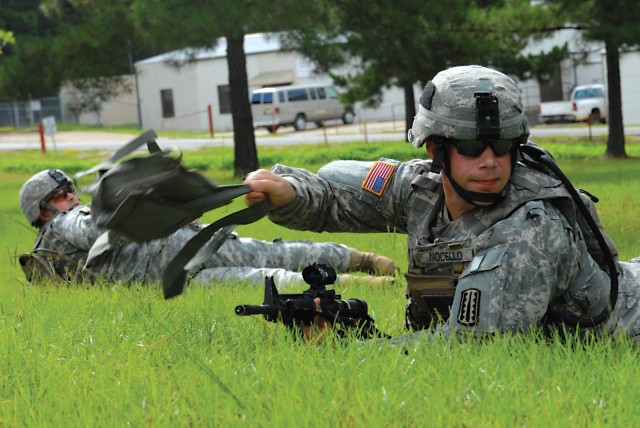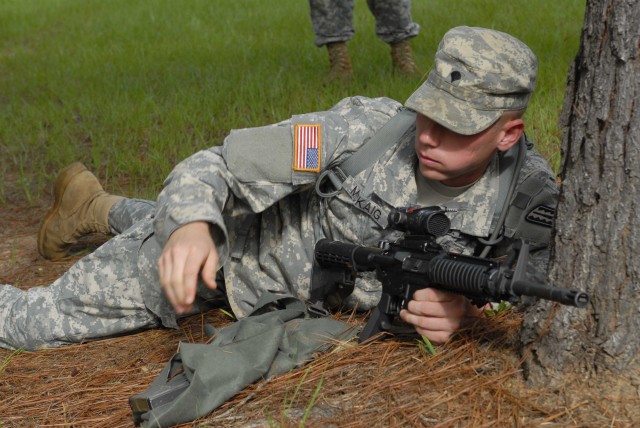FORT BENNING, Ga. (Aug. 28, 2009) -- Soldiers from the Maneuver Battle Lab's experimentation force tossed around the current M-8 bandoleer and a candidate replacement version during a weeklong assessment on Fort Benning.
Eighteen members of A Company, 1st Battalion, 29th Infantry Regiment took part in the strength and dependability tests, which included a look at how easily they could access the clipped 5.56mm ammunition from the bags. The evaluation was held Aug. 17-21 at the McKenna Urban Operations Complex.
The M-8 bandoleer is a bag with small pockets for storing cartridges and magazines, worn over the shoulder and across the chest.
Lisa Aversa, a packaging engineer from Picatinny Arsenal in New Jersey who observed the limited objective experiment, said the bandoleer now in use by the Army and Marine Corps is oblong-shaped with four pockets and made of cotton or a cotton-polyester blend. The potential replacement is all polyester, features two pockets and is produced through ultrasonic welding, which makes it more compact. Both bags hold 120 rounds of ammo.
Early in the week, the Soldiers took both bandoleers on McKenna's individual movement technique, or IMT, obstacle course. Evaluators also measured how far the Soldiers could throw the bags.
They resupplied each other during mock daytime and nighttime raids on a building and house, tossing the bandoleers through a second-floor window. In a separate scenario, they distributed ammunition along the perimeter of a "patrol base" under attack.
Large containers with fully packed bandoleers for U.S. troops have been dropped on battlefields for more than 50 years, said Niral Patel, a packaging engineer from Picatinny Arsenal.
"The ammo can be distributed quicker or carried quicker," he said. "You can throw it over your shoulder and go."
But many Soldiers from the experimentation force said the present bandoleer was sturdier than the candidate replacement version. Some also said they'd rather use other ammo-dispersal methods in combat.
"The material on the new one is brittle. It's not as tough as the old one," said Spc. James Mocello. "When the new ones get tension on them, they just break off."
Sgt. William MacMillan said the candidate bandoleers "tear pretty easily" on the obstacle course and while throwing them around to other Soldiers. He fears "bandoleers would be (strewn) all over the place" in a firefight.
"We found better ways to distribute ammunition - especially in combat," MacMillan said. "Any time we need to refit each other, I never have used bandoleers. We normally use a rucksack or backpack because you can carry more ammo, and it's easier to distribute.
"If I had to pick, the old (bandoleer) works better. But if there needed to be a change, I don't think it matters, because we really don't use them anyway."
Soldiers aren't being told to choose the bandoleer over a backpack or rucksack, Patel said. But he said he thinks the candidate replacement version is a better option than the current bag because the new design uses less material, which makes it easier to unload and repack small-caliber ammunition.
"Any candidate bandoleer should be as good as or better than the current one," said Jonathan Porter, a project officer for the Maneuver Battle Lab's futures branch. "Even though Soldiers might not use it all the time, it should provide equal or better capabilities. Our main objective was to assess the durability and reliability between the two to get a comparison."
Aversa said cost savings in manufacturing the candidate M-8 bandoleer could be significant because polyester is less expensive than cotton per square foot.
"We'll be looking at things we could maybe tweak in the design," she said.
Officials said any prototype changes would be based on the Maneuver Battle Lab's final report, which is due Oct. 2. An integrated product team will ultimately decide whether the current bandoleer is replaced.




Social Sharing